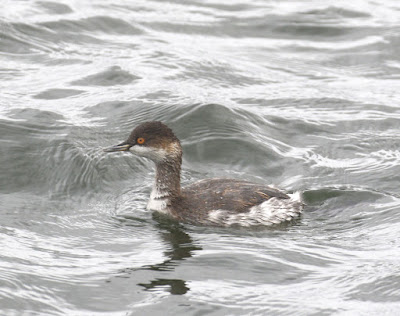I confess to having been rather taken by the Black necked Grebe that is currently gracing the waters by the concrete shores of Farmoor and which I went to see last Thursday, so I took myself off there today to make its re-acquaintance.
What a difference today's weather offered to Thursday's sun and blue sparkling water. Not a sign of any sun today and a brisk southeasterly wind turned the reservoir's waters into a wave tossed gunmetal grey.
The Black necked Grebe was, however, in the same location by the southern perimeter wall, swimming and diving busily, near to the Coots. Tossing about in the small wave troughs and often quite hard to see as its predominantly greyish white plumage mirrored the dull silver light on the water's surface.
The reservoir was busy today with more than its usual number of birders and photographers, the numbers doubtless swollen by news of this grebe's presence and that of its fellow scarce visitor the Red necked Grebe. A guided party of birders from Buckinghamshire some fifteen strong were also walking the perimeter.
It was noticeable that the grebe was troubled by the numbers and would swim further out into the reservoir when people passed and bright colours also seemed to trouble it, as when a lady in a bright cerise pink windproof jacket passed by, causing the grebe to paddle its way rapidly further out into the reservoir, its plumage flattened and its neck and head held high in a posture of extreme alert. As soon as she had passed it relaxed and slowly by a series of dives arrived back near to the shoreline
The reason for its preference to be near the shore was obvious. Many small fish swim in the shallows and were easy prey to such a proficient hunter. The fish seemed to be mainly Three spined Sticklebacks but undoubtedly there were other species, but they were either too small or swallowed too quickly if caught by the grebe to be identified with any certainty. Occasionally the grebe would feed on bits of weed on the surface, picking at it with delicate stabs of its bill and after one dive, for a little time trailed cotton thin lines of green weed from its bill, no doubt caught up as it chased a fish underwater through the weed.
Mark and a colleague from Cardiff were endeavouring to capture images of the grebe, their equipment so much more sophisticated and expensive than mine. After several attempts at getting close the grebe lost much of its former wariness, maybe because it was just the three of us now, standing or crouching in subdued clothing by the retaining wall and Mark's colleague who had especially traveled all the way from Cardiff this morning to photograph the grebe got the images he wanted
The Black necked Grebe dived and surfaced for some time, working its way along about a hundred and fifty metres of shallows and then relaxed and obviously replete sunk its bill into its chest in typical grebe fashion and slept, always with one eye open, the eye now appearing more orange in the dull light rather than the livid red of sunnier times.
I reflected on the grebe's future. Would it remain here for the winter or move on to wherever it will spend the winter if not here? They are gregarious in winter so maybe it will leave its solitary existence on Farmoor to search for others of its kind. The authoritative Birds of The Western Palearctic states they winter on lakes, reservoirs and coastal waters but in Britain they seem to prefer the coast but you never know. There are always exceptions but in reality it is likely to move on soon so I fully intend to enjoy it while I can and will hopefully be able to make another visit before it goes.
An amazing fact about them is that they are flightless for nine to ten months of the year, the longest flightless period of any flying bird.They have very weak pectoral muscles and are extremely bad fliers only using flight for migration, but just to confound matters they can still manage to fly huge distances, up to 3700 miles, on migration to and from their breeding areas despite their poor flying ability. From what I saw of this bird on Thursday it currently has a full complement of flight feathers so probably it will fly off before it becomes flightless. In cases of extreme danger they prefer to dive and flee underwater where their supreme swimming and diving ability comes to the fore.
In the United States of America they are known as Eared Grebes and there are about four million of them after the breeding season and one to two million of these are to be found on one lake in autumn, Mono Lake in California, where they go to moult and become flightless for up to ten months. The lake was only saved for posterity by a lengthy and protracted legal battle that went all the way to the Californian Supreme Court. They are the most abundant grebe in the world being found everywhere at various times of the year except Antarctica and Australia. However in the UK they are rare with a population of no more than 35-63 pairs breeding at twenty one sites, all in England apart from one which is in Scotland.
We walked back along the reservoir's perimeter and I said goodbye to Mark and his Welsh colleague. I headed for the Yacht Club cafeteria and joined the men and women in wet suits for some refreshment. A sausage bap, chips and a mug of tea all served with a smile. Two pounds fifty the lot - an absolute bargain.








No comments:
Post a Comment